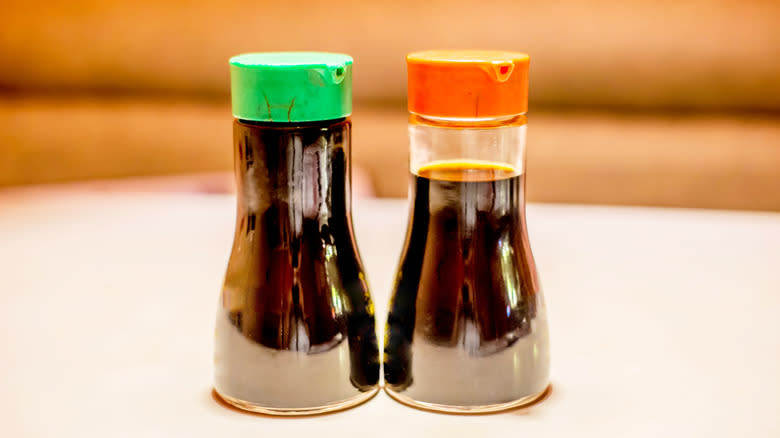How Much Sodium Is Actually In Soy Sauce?

Soy sauce is known for its unique taste and versatility in various dishes worldwide, but it has also garnered a reputation for being high in sodium. When it comes to the exact sodium content, the levels vary significantly depending on the soy sauce brands and types. Here in the U.S., Japanese soy sauces are among the most commonly used. Brands like Kikkoman and Yamasa are household names, and their most popular offerings are dark soy sauces. One tablespoon of these popular Japanese options typically contains between 900 and 1,000 milligrams of sodium.
On the other hand, there are Chinese soy sauces, arguably the second most common variety in America, including brands like Pearl River Bridge, Kimlan, and Lee Kum Kee. The light soy sauce types of these brands generally contain more sodium than the Japanese brands, and range from 1,000 to 1,200 milligrams per tablespoon, while the dark versions, which are thicker and richer, contain even more — often between 1,100 and 1,400 milligrams per tablespoon.
To put all this into perspective, 1 tablespoon of table salt contains nearly 7,000 milligrams of sodium. This means that while soy sauce can be considered high in sodium, it's not as concentrated as pure salt, and that's one reason why some people use it as a salt substitute — to consume less sodium. The other reason is the flavor profile it adds to food.
Read more: The 15 Healthiest Chip Brands, Ranked From Worst To Best
Low Sodium Options And The Flavor Profiles Of Different Soy Sauces

If all that seems like too much sodium for your dietary needs or preferences, note that almost all brands of this condiment offer low-sodium options for those who want the flavor of the sauce without as much salt. These typically contain about 500 to 600 milligrams of sodium per tablespoon, which is about 20% to 40% less than the regular type. This reduction allows for more flexibility in cooking with it, while keeping sodium intake in check.
All that said, soy sauce is more than just a source of sodium; it's a flavor powerhouse that can transform dishes with its savory, umami profile. Moreover, there are other nuances of flavor depending on the rest of the ingredients found in various types of soy sauce. This complexity is what makes the condiment so versatile and widely used in cooking.
For example, Chinese dark soy sauce has a more pronounced sweetness compared to the light type due to the addition of molasses. The extra sweetness masks the saltiness from the high sodium content to some extent, creating a richer, thicker sauce that adds depth to dishes. Seasoned soy sauces, on the other hand, offer even more variety. For example, mushroom-flavored soy sauce combines the typical salty notes with an earthy mushroom taste, enhancing the umami experience. These small yet significant variations allow cooks to experiment with different tastes to create unique dishes.
Read the original article on Tasting Table

